The first “Salon du Livre d’Histoire” in Grasse, also described as a “Bouquet d’Histoires”, was held the weekend of 12-14 April 2024. I was curious enough to venture out on a sunny spring Saturday afternoon to see what it was all about. First, I joined a guided tour featuring the history of the French Revolution in Grasse itself. I was surprised to discover many landmarks that I had not noticed before. I then visited the salon’s official events in the Palais des Congrès. I met a young historian whose book on “Danton and Robespierre, Le choc de la Révolution” caught my eye.
Of course, I bought the book, and the young author, Loris Chavanette, graciously signed it with a nice message, although I wasn’t able to decipher one of his words. He described the book as “la naissance de la démocratie dans la douleur, avec l’espoir (indecipherable word) du progrès”. The English translation would be something like: “the birth of democracy in pain, with the hope of (illegible word) progress.” We talked about the tragedy of how the friendship between Danton and Robespierre fell apart, with each one of them ultimately being executed in the Reign of Terror. The story, said the young author, depicts the historical tensions that exist within French democracy.
We then talked about another of his book on display – entitled “La Tentation du Desespoir, Comment la Démagogie Menace la Démocratie”. The English translation would be “The Temptation of Despair, How Demagogy Threatens Democracy”. His focus in this book is on the contemporary French phenomena of would-be demagogues on both the extreme left and the extreme right.
I remarked how this might resonate in US politics today, although we don’t really have a left-wing demagogue to contend with. But I decided to buy this book as well, for which his gracious message went as follows: “un essai du compréhension de notre présent démocratique , en espérent que ces chapitres vous suggèrent méditation”. I would translate that as : “an attempt to understand our democratic present, hoping that these chapters will stimulate you to think”. Here, by the way, is the author (on the right) chatting with Mayor Jerome Viaud.

The Mayor was enjoying this inaugural salon as he toured around this particular room in the Palais des Congrès where numerous authors were available to promote their books. I was tempted to buy several others and did opt for one on “Grasse, L’usine à parfums” – i.e. “Grasse, the Perfume Factoy”! Another on Simone Veil, I decided, could wait until the next year. I didn’t go to any of the roundtables or lectures or workshops, either, but I am as hopeful as anyone in Grasse that this salon is the beginning of a regular annual event.
As for the tour, here are a few photos of what I discovered. Our guide, Gilles Burois, started the tour at the “Fountain of Wisdom” with an obelisk that I had never noticed before. It is located to one side of the Cours Honoré Cresp, a plaza that also happens to include the statue of the Admiral de Grasse. We have often attended ceremonies centered around this statue, honoring the commander of the French Navy in the Battle of the Capes during the American Revolution. The defeat of the British ships was instrumental in the Battle of Yorktown that effectively ended the Revolutionary War in 1781.
What a surprise to learn about this other monument, erected in 1792 as a testament to the French Revolution! The four faces of the obelisk feature the four “great values” of the Revolution – the importance of the arts perfecting nature, the defense of the homeland, the welfare of the people and the prosperity of the state.
Later in the tour, the guide took us through the streets of the old town where he pointed out the structure where one of the courts tried and convicted the opponents to the French Revolution during the Reign of Terror. There were, of course, no markers for this structure, which is today part of the thriving network of Fragonard shops and museums. Elsewhere, though, there is a memorial plaque for the 30 people who were executed by guillotine in Grasse.
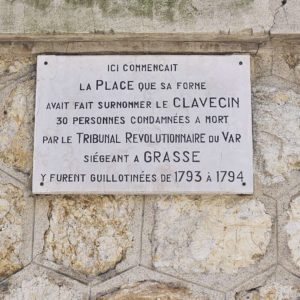
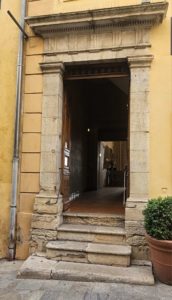
One of the natives of Grasse who survived this Reign of Terror by fleeing Paris for a refuge back in Grasse was none other than the well-known French painter Jean-Honoré Fragonard. The Jean-Honoré Fragonard Museum, opened in 2011, is in a villa whose then owner, the successful perfumer Alexandre Maubert welcomed Jean-Honoré in 1790 to flee the rampage in Paris.
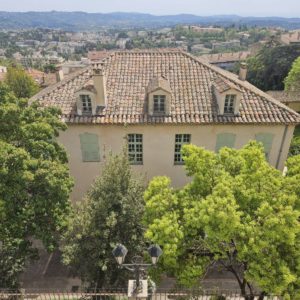
The villa, which was located just outside the old walls of Grasse, with a fine view of the sea, is just below the Cours Honore-Cresp. The guide showed us how Fragonard’s artistry embellished the grand staircase of this villa with an elaborate display of “chiaroscuro” architecture. Fragonard linked classical and masonic images with explicit revolutionary references and symbols.
Among the symbols of the new regime was the rooster or cock, as displayed in Fragonard’s tribute to “the law”. I suspect that the female face there is also another French symbol, an early version of Marianne, the name which symbolically represents the people of France.

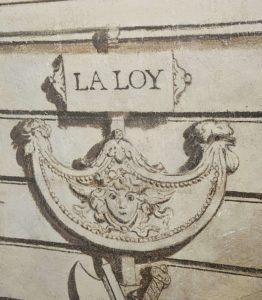
On this occasion, Fragonard was only in Grasse in 1790 and 1791, even before the worst of the Reign of Terror. It would seem that his art work on the walls of this grand staircase contributed to his distancing himself from the aristocracy. After he returned to Paris, he was actually appointed the curator of the newly created French National Museum, the precursor of The Louvre.
Another part of the tour was in the new International Museum of Perfumerie that includes a series of rooms tracing the historical origins and evolution of perfume. Here, the guide showed us a room specifically dedicated to honoring the French citizenry with all the symbols of the French Revolution – even featuring tricolor stripes of blue, white and red on the walls.

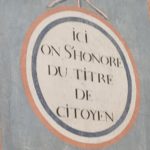
The slogan on display there reads «Les hommes sont egaux devant la loi” – «All men are equal under the law”. The opposite wall contains the slogan “Ici, on s’honore au titre de citoyen”. A loose translation of that would be “Here we honor the title ‘citizen’.” Even in the history of perfume, then, there was a transformation driven by the French Revolution.
Finally, it was in 1790 that the main administrative structure in France, the “departments”, were established to replace the system of provincial privileges under the abolished monarchy. While the number of departments has varied from time to time, the departmental unit is still operational today.
As the guide explained, the original plan was to name each department with a geographic landmark. Grasse was initially included in the department called Var (after the river) and was actually the headquarters for Var. Here is a plaque showing the residence of the first mayor of Grasse under this new structure. 

This new system also played a role, of course, in the Reign of Terror, thus the role of Grasse in condemning 30 people to the guillotine in 1793 and 1794. The guide did not show us where the main tribunal was for these proceedings, but I learned later that it was in a building just below the International Museum of Perfume, where another smaller museum is now located – lo and behold, a marine museum connected to the Admiral de Grasse!
 And it seems that a quick reorganization of the new departments resulted in Grasse and its environs being cut out from Var and placed with Nice in the new department of Alpes-Maritimes. The result is that Var is about the only department in France named after a geographic landmark that is not within its borders. The Var River flows to the sea to the east of Grasse, while the department of Var is entirely to the west of Grasse.
And it seems that a quick reorganization of the new departments resulted in Grasse and its environs being cut out from Var and placed with Nice in the new department of Alpes-Maritimes. The result is that Var is about the only department in France named after a geographic landmark that is not within its borders. The Var River flows to the sea to the east of Grasse, while the department of Var is entirely to the west of Grasse.
There were other aspects of the tour that I didn’t capture in informative photographs. There was, for example, a plaque for the birthplace of a general from Grasse who was part of a pro-Republican plot to overthrow Napoleon. I understand that he was not “guillotined” but rather was sentenced to death by firing squad. Well, that does require some additional research on how Napoleon managed to juggle the complexities of revolutionary and counter-revolutionary impulses in France – not exactly relevant to a tour of Grasse.
I do know that the various monasteries in Grasse were closed down by the Revolution and converted to other uses. Many of them (Franciscans, Dominicans) were initially occupied by perfume factories, but one became the town theater (Augustins). This latter now houses a bank on the ground floor and a cluster of language classes on an upper floor (where I study Spanish).
Another interesting fact mentioned by the guide was that the 13th century cathedral in Grasse, which had been converted by the revolutionaries to a granary, suffered a massive fire in 1792. I didn’t quite understand if the fire was some sort of sabotage, but I do know that the fire lasted several days. It must have been quite chaotic. We didn’t go into the cathedral during this tour, but I have been inside it on several occasions without noticing this aspect of its history. Clearly, the structure of the cathedral survived, but some of the central columns were badly damaged and still show the burn marks. I’ll be sure to look for them on my next visit.

